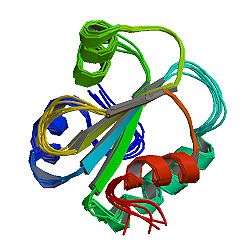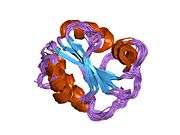ERP29
Endoplasmic reticulum protein 29 (ERp29) is a chaperone protein that in humans is encoded by the ERP29 gene.[1]
Function
ERp29 is a reticuloplasmin, a protein which resides in the lumen of the endoplasmic reticulum (ER). The protein shows sequence similarity to the protein disulfide-isomerase family.[2] However, it lacks the thioredoxin motif characteristic of this family, suggesting that this protein does not function as a disulfide isomerase.[2] The protein dimerizes and is thought to play a role in the processing of secretory proteins within the ER. Alternative splicing results in multiple transcript variants encoding different isoforms.[1]
References
- 1 2 "Entrez Gene: ERP29 endoplasmic reticulum protein 29".
- 1 2 Galligan JJ, Petersen DR (July 2012). "The human protein disulfide isomerase gene family". Human Genomics 6 (6): 6. doi:10.1186/1479-7364-6-6. PMC 3500226. PMID 23245351.
Further reading
- Hubbard MJ (Sep 2002). "Functional proteomics: The goalposts are moving". Proteomics 2 (9): 1069–78. doi:10.1002/1615-9861(200209)2:9<1069::AID-PROT1069>3.0.CO;2-R. PMID 12362325.
- Mkrtchian S, Sandalova T (2006). "ERp29, an unusual redox-inactive member of the thioredoxin family". Antioxidants & Redox Signaling 8 (3-4): 325–37. doi:10.1089/ars.2006.8.325. PMID 16677078.
- Hochstrasser DF, Frutiger S, Paquet N, Bairoch A, Ravier F, Pasquali C, Sanchez JC, Tissot JD, Bjellqvist B, Vargas R (Dec 1992). "Human liver protein map: a reference database established by microsequencing and gel comparison". Electrophoresis 13 (12): 992–1001. doi:10.1002/elps.11501301201. PMID 1286669.
- Hughes GJ, Frutiger S, Paquet N, Pasquali C, Sanchez JC, Tissot JD, Bairoch A, Appel RD, Hochstrasser DF (Nov 1993). "Human liver protein map: update 1993". Electrophoresis 14 (11): 1216–22. doi:10.1002/elps.11501401181. PMID 8313870.
- Mkrtchian S, Fang C, Hellman U, Ingelman-Sundberg M (Jan 1998). "A stress-inducible rat liver endoplasmic reticulum protein, ERp29". European Journal of Biochemistry / FEBS 251 (1-2): 304–13. doi:10.1046/j.1432-1327.1998.2510304.x. PMID 9492298.
- Ferrari DM, Nguyen Van P, Kratzin HD, Söling HD (Aug 1998). "ERp28, a human endoplasmic-reticulum-lumenal protein, is a member of the protein disulfide isomerase family but lacks a CXXC thioredoxin-box motif". European Journal of Biochemistry / FEBS 255 (3): 570–9. doi:10.1046/j.1432-1327.1998.2550570.x. PMID 9738895.
- Hubbard MJ, McHugh NJ (Nov 2000). "Human ERp29: isolation, primary structural characterisation and two-dimensional gel mapping". Electrophoresis 21 (17): 3785–96. doi:10.1002/1522-2683(200011)21:17<3785::AID-ELPS3785>3.0.CO;2-2. PMID 11271497.
- Shnyder SD, Hubbard MJ (Apr 2002). "ERp29 is a ubiquitous resident of the endoplasmic reticulum with a distinct role in secretory protein production". The Journal of Histochemistry and Cytochemistry 50 (4): 557–66. doi:10.1177/002215540205000413. PMID 11897809.
- Sargsyan E, Baryshev M, Backlund M, Sharipo A, Mkrtchian S (Feb 2002). "Genomic organization and promoter characterization of the gene encoding a putative endoplasmic reticulum chaperone, ERp29". Gene 285 (1-2): 127–39. doi:10.1016/S0378-1119(02)00417-1. PMID 12039039.
- Basrur V, Yang F, Kushimoto T, Higashimoto Y, Yasumoto K, Valencia J, Muller J, Vieira WD, Watabe H, Shabanowitz J, Hearing VJ, Hunt DF, Appella E (2003). "Proteomic analysis of early melanosomes: identification of novel melanosomal proteins". Journal of Proteome Research 2 (1): 69–79. doi:10.1021/pr025562r. PMID 12643545.
- Lim J, Hao T, Shaw C, Patel AJ, Szabó G, Rual JF, Fisk CJ, Li N, Smolyar A, Hill DE, Barabási AL, Vidal M, Zoghbi HY (May 2006). "A protein-protein interaction network for human inherited ataxias and disorders of Purkinje cell degeneration". Cell 125 (4): 801–14. doi:10.1016/j.cell.2006.03.032. PMID 16713569.
- Cheretis C, Dietrich F, Chatzistamou I, Politi K, Angelidou E, Kiaris H, Mkrtchian S, Koutselini H (Oct 2006). "Expression of ERp29, an endoplasmic reticulum secretion factor in basal-cell carcinoma". The American Journal of Dermatopathology 28 (5): 410–2. doi:10.1097/01.dad.0000211521.49810.ac. PMID 17012915.
- Zheng J, Liu X, Yan X, Dai L, Ji C (2006). "Purification and structural characterization of human ERp29". Protein and Peptide Letters 13 (8): 753–9. doi:10.2174/092986606777841190. PMID 17073718.
- Chi A, Valencia JC, Hu ZZ, Watabe H, Yamaguchi H, Mangini NJ, Huang H, Canfield VA, Cheng KC, Yang F, Abe R, Yamagishi S, Shabanowitz J, Hearing VJ, Wu C, Appella E, Hunt DF (Nov 2006). "Proteomic and bioinformatic characterization of the biogenesis and function of melanosomes". Journal of Proteome Research 5 (11): 3135–44. doi:10.1021/pr060363j. PMID 17081065.
- Lippert U, Diao D, Barak NN, Ferrari DM (Apr 2007). "Conserved structural and functional properties of D-domain containing redox-active and -inactive protein disulfide isomerase-related protein chaperones". The Journal of Biological Chemistry 282 (15): 11213–20. doi:10.1074/jbc.M604440200. PMID 17296603.
| |||||||||
This article is issued from Wikipedia - version of the Wednesday, February 10, 2016. The text is available under the Creative Commons Attribution/Share Alike but additional terms may apply for the media files.


